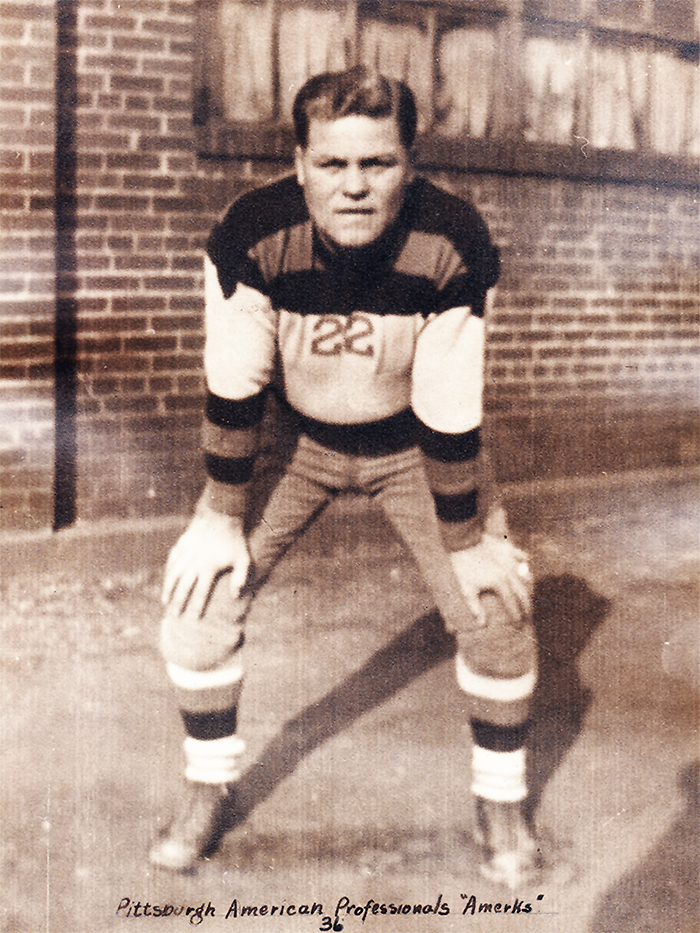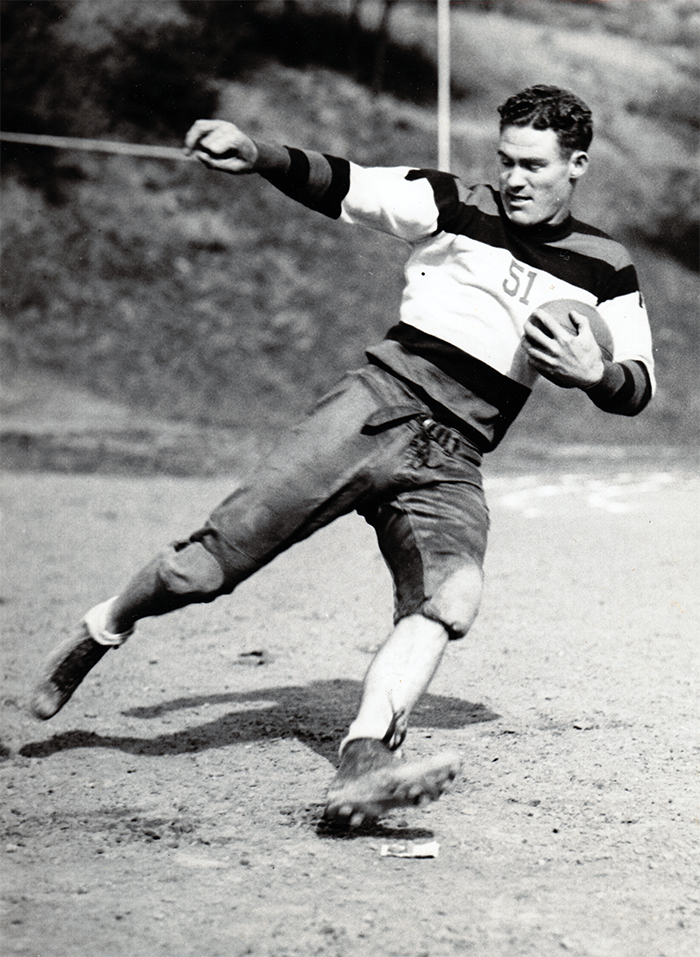Foreword:
When the NFL finally made these shores across the Atlantic in 1982, I chose the Steelers as the team that I would support. I had missed the glorious seventies and the four Super Bowls, but I was committed to Pittsburgh and the Steelers from that year.
Over the many years that I enjoyed visiting Pittsburgh, I’ve grown fond of the city and its football history even to the extent that I have a Maulers (of the USFL) shirt and pennant hanging on my wall.
I research the Steelers history all the time, mostly for this web site, although I do write for two others. Is it because I have time on my hands or because I am captivated by all things black and gold? You be the judge because I can’t decide.
While going through the old newspapers and trust me, it’s not easy having a football team with the same name as the more popular baseball team, I discovered a team called the Pittsburgh Americans was set up in a rival league to our Steelers (at the time they were the Pirates).
The beginning:
In November 1935, Dr. Harry A March disclosed plans for a new eight club professional football circuit to be known as the American Professional Football League.
Dr. March had been heavily involved in football since the early 1900s while living in Canton, Ohio and went on to hold several positions with the New York Giants. Allegedly, he decided to start the new professional league after a dispute with the Redskins’ influential owner George Marshall over the rights to Fordham’s Ed Danowski.
Dr. March emphasised there would be no territorial war with the NFL when he announced the new league would be confined to cities in the north eastern area of the United States, bounded by New England and Ohio. The following cities were listed as applying for membership:
Providence, Hartford, Albany, New York, Rochester, Buffalo, Pittsburgh, Cleveland, Cincinnati, Akron, Baltimore, Washington, Newark, Jersey City and Paterson, N.J.The final makeup will be decided at a meeting in New York in December. Dr. March emphasised there will be no territorial war with the NFL.
Pittsburgh was assured of a franchise in the proposed league with Richard Guy Jr., heading a consortium of local businessmen whose identity was not confirmed. Guy was a former sports editor and business manager with the Pittsburgh Pirates football team.The American League was projected to be as strong as or stronger than the NFL. Existing contracts of the National League will be respected and there will be no poaching of their players. The intention was to dovetail schedules where teams from each league were in one city.
At a meeting on April 11th 1936, the new league was formally organised with franchises being granted to Boston, New York, Jersey City, Syracuse, Cleveland, Pittsburgh, Philadelphia and Providence. Each club was required to post a bond as surety for completing the season and to encourage the fulfilment of their obligations.
It was agreed that teams would have 25 players available for the first three games before the player limit was cut to 22.
The Pittsburgh franchise began to look for a coach while searching for a team name. A tentative agreement had been in place for John J Molenda, a former Michigan University fullback with seven years pro experience, to take charge. Molenda though decided to go to New York when a coaching vacancy opened up there.
Eventually, Rudy Comstock, a veteran football player and the former coach of the Oklahoma State College team, was chosen as the coach for the Pittsburgh Americans as the name for the team also emerged.
Joe Keeble:
Joe Keeble played a pivotal part in the Pittsburgh Americans’ inaugural season in the American Professional Football League. He learnt his trade at the University of Southern California.
In 1930, Keeble playing halfback helped the freshman team complete their third straight season unbeaten.
A year later, in a game before 35,000 fans, Keeble was instrumental in guiding his team to a 13-0 win over the Florida Gators. At the time, the victory was celebrated as “the first time a team from below the Mason and Dixon line had been beaten by a Pacific Coast gridiron team for the first time in intersectional play.”
Taking possession on the ‘Gator 42-yard line, Keeble faded back to midfield and rifled a portside pass to fellow half-back Bobby Decker, who fought the ball away from two Florida defensive backs and took it to the 14-yard line.
On third down, Keeble tossed a sharp pass to Mulhaupt on the two before taking it in for the score. Keeble then took his team on a 9-play drive of 59 yards that finished when he ran it in from the 1-yard line.
Joe Keeble graduated in 1934 and then found he was in demand to play semi-pro football in California. Not a lot of non-college football was being played in the state and the highlight would be the visit of NFL teams after their season finished.
Pro teams would travel to play exhibition games and the west coast was a favourite location. Demonstrating the National Football League to pro-football starved fans was one way to add to the owners’ and players’ pockets.
At the beginning of 1935 the Chicago Cardinals were in California to play some games and also scout the local talent. The Cardinals’ coach Paul Schissler signed several players including Keeble.
After playing two local teams, the Cardinals met the Chicago Bears before 15,000 fans and left Gilmore Stadium with a 13-9 win. The gate money was estimated to have been $15,000 although the Cardinals share was impounded because of a legal dispute.
It is unlikely that Keeble played in the game. The Bears’ coach George Halas had protested over Keeble’s earlier signing with the Cardinals and had left it with the local league to resolve the dispute.
Keeble was recognised as the best of the left handed passers when he graduated in 1935. In September that same year, a professional football league was formed in southern California involving four teams with the season beginning a month later. The teams were the California Shamrocks, the Los Angeles Maroons, the Hollywood Braves and the Westwood Cubs.
The idea behind the league was the Los Angeles county council of the American Legion with the aim of promoting the sport by had a maximum admission charge of 40 cents. Any profit made would be used for the relief of needy disabled veterans from the World War.
Keeble played for the Cubs who defeated the Braves 13-7 in the season opener, scoring on two blocked punts.
Since the NFL added a new rule to prevent their teams from playing each other in post season exhibition teams, the Bears would be playing teams from the newly created league when they made their trip to California.
American Legion Professional Football league results:
Westwood Cubs 7 Shamrocks 0
Cubs 13 Maroons 15
Cubs 27 Shamrocks 0
Cubs 35 Braves 20 - Santa Ana Municipal Bowl
Cubs 10 Braves 3
Cubs 7 Maroons 7Keeble scored two rushing touchdowns before a crowd of 500 fans who paid approximately $150 to watch the free scoring game.
The final game of the season decided the league’s title and the right to play the Detroit Lions, the national champions in an exhibition game. After a postponement due to rain, the game was played.
Before the game, a local newspaper described Joe Keeble “ as a fullback who has developed into one of the greatest all around ball carriers in the pro ranks and he will be out to prove that he can go through the Lion line and also deceive them on passes.”
On January 12th 1936, the Cubs and Joe Keeble were overwhelmed 67-14 in front of a 16,000 crowd by the professional team highlighting the large gap in talent between the top league from the east and the infant west coast league.
When the AMERKS became part of the National Football League, they began looking for players and extended their search to the west coast with their selection of Jo Keeble.
THE PITTSBURGH AMERICANS KICKOFF
While the NFL’s Pirates were playing exhibition games against the Edgar Thomson eleven and the Rox Rangers, the APFL’s Amerks were preparing for their league debut.
The Americans’ camp opened on September 7 1935 with the news that the Cleveland team, who were to be their first opponents, had withdrawn from the league. Cleveland’s demise appeared to be due to a request from the league’s president asking for $500 from each team to move the Rochester franchise to Brooklyn.
In those early years, pro football wasn’t awash with the money that it is currently swamped in. Cleveland’s team was headed by Damon Wetzel, star fullback at Ohio State and part of the Pirates roster the previous year.
Within a week of withdrawing from the league, the Cleveland team had changed hands and was back in. Willies Reynolds brought the franchise and kept coach Buzz Wetzel in charge. It was Wetzel who had put in all the hard work to establish a team in Cleveland.
In 1937, the Rams tried to draft Byron White, but at the time he said that he wasn’t going to join the pro football ranks.
There was an interesting preview of the Amerks at Cleveland game on November 1st in the Pittsburgh press.:
“The Pittsburgh Americans are in Cleveland today to battle the Cleveland Rams in an AFL game. The Americans by winning may climb into the first division.
The Amerks-Rams clash is expected to be an aerial battle for both teams have been proficient throughout the season with the forward pass. The Rams have an ace passer in Stan Pincura, former Ohio State quarterback.
The Americans boast three student tossers in Dick Beltz, also a former Ohio State flash; Bob Synder and Joe Keeble.
The Rams have two former Pitt athletes and one former Duquesne star in their lineup. Mike Sebastian, halfback and Art Detzel, tackle were recent Panther luminaries. Ben Ciccone, center, starred at Duquesne and later with the Pirates.
Cleveland has won two games, tied one and lost one. Their only defeat being at the hands of the league-leading Boston Shamrocks. Pittsburgh has won two from Syracuse (which is now Rochester) and Brooklyn and has lost a pair to Boston and New York.”
The first ever Pittsburgh-Cleveland pro football game finished 7-7. The Amerks took the lead in the second quarter after recovering a fumble on the Cleveland 18-yard line. On the back of some fine punting from Bob Snyder that took his team out of some threatening holes their opponents created.
In the final quarter, coach Wetzel guided the Rams to the touchdown that tied the game.
In the scheduled return fixture, fun and games that were the way of life in early pro football again came to fore. Cleveland’s Wetzel refused to permit his team to take to the field until he had been paid their $3,000 guarantee money.
Wintry conditions suddenly overtook Pittsburgh before the game and probably led to the poor turnout of 500 spectators who were given a refund with the game’s cancellation.
Joe Keeble

